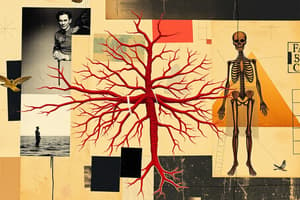Podcast
Questions and Answers
What is the primary function of the peripheral nervous system (PNS)?
What is the primary function of the peripheral nervous system (PNS)?
- To facilitate communication between the CNS and the rest of the body. (correct)
- To regulate body temperature.
- To directly control skeletal muscles.
- To process complex thoughts and emotions.
Which division of the peripheral nervous system (PNS) is responsible for conveying information from sensory receptors in the skin, skeletal muscles, and joints?
Which division of the peripheral nervous system (PNS) is responsible for conveying information from sensory receptors in the skin, skeletal muscles, and joints?
- Somatic Sensory Division (correct)
- Visceral Motor Division
- Autonomic Division
- Motor Division
What type of control does the somatic motor division exert over skeletal muscles?
What type of control does the somatic motor division exert over skeletal muscles?
- Involuntary
- Reflexive
- Voluntary (correct)
- Autonomic
Which of the following describes the function of autonomic sensory neurons?
Which of the following describes the function of autonomic sensory neurons?
What is the general function of autonomic motor neurons?
What is the general function of autonomic motor neurons?
What is the role of the synapses between neurons in sensory pathways?
What is the role of the synapses between neurons in sensory pathways?
Where is the cell body of the first-order neuron in a sensory pathway typically located?
Where is the cell body of the first-order neuron in a sensory pathway typically located?
In the somatic nervous system, how does an upper motor neuron in the CNS control skeletal muscle fibers?
In the somatic nervous system, how does an upper motor neuron in the CNS control skeletal muscle fibers?
What is the effect of stimulation of a lower motor neuron on skeletal muscle fibers?
What is the effect of stimulation of a lower motor neuron on skeletal muscle fibers?
What is the primary role of preganglionic neurons in the autonomic nervous system (ANS)?
What is the primary role of preganglionic neurons in the autonomic nervous system (ANS)?
What is the role of ganglionic neurons in the autonomic nervous system?
What is the role of ganglionic neurons in the autonomic nervous system?
What is the general effect of stimulating ganglionic neurons in the autonomic nervous system (ANS) on visceral effectors?
What is the general effect of stimulating ganglionic neurons in the autonomic nervous system (ANS) on visceral effectors?
What is the primary distinction between autonomic and sensory ganglia?
What is the primary distinction between autonomic and sensory ganglia?
The adult spinal cord typically ends?
The adult spinal cord typically ends?
What is the cauda equina?
What is the cauda equina?
Why are the cervical and lumbar enlargements of the spinal cord important?
Why are the cervical and lumbar enlargements of the spinal cord important?
How many spinal nerve pairs arise from the spinal cord?
How many spinal nerve pairs arise from the spinal cord?
If the spinal cord ends at the L1 vertebra, where would you typically find the S5 segment?
If the spinal cord ends at the L1 vertebra, where would you typically find the S5 segment?
Which of the following is a characteristic of the dura mater?
Which of the following is a characteristic of the dura mater?
What is the function of the filum terminale?
What is the function of the filum terminale?
Flashcards
Peripheral Nervous System
Peripheral Nervous System
Communication between the CNS and the rest of the body.
Sensory (Afferent) Division
Sensory (Afferent) Division
Conducts impulses from receptors to the CNS, informing it of the body's internal and external states.
Motor (Efferent) Division
Motor (Efferent) Division
Conducts impulses from the CNS to effectors (muscles/glands).
Somatic Sensory Neurons
Somatic Sensory Neurons
Signup and view all the flashcards
Somatic Motor Neurons
Somatic Motor Neurons
Signup and view all the flashcards
Autonomic (Visceral) Sensory Neurons
Autonomic (Visceral) Sensory Neurons
Signup and view all the flashcards
Autonomic Motor Neurons
Autonomic Motor Neurons
Signup and view all the flashcards
Sensory Somatic Pathway
Sensory Somatic Pathway
Signup and view all the flashcards
First-order Neuron
First-order Neuron
Signup and view all the flashcards
Second-order Neuron
Second-order Neuron
Signup and view all the flashcards
Third-order Neuron
Third-order Neuron
Signup and view all the flashcards
Somatic Nervous System
Somatic Nervous System
Signup and view all the flashcards
Dura mater
Dura mater
Signup and view all the flashcards
Arachnoid Mater
Arachnoid Mater
Signup and view all the flashcards
Pia Mater
Pia Mater
Signup and view all the flashcards
Filum Terminale
Filum Terminale
Signup and view all the flashcards
Epidural Space
Epidural Space
Signup and view all the flashcards
Subarachnoid Space
Subarachnoid Space
Signup and view all the flashcards
Spinal Cord
Spinal Cord
Signup and view all the flashcards
Conus Medullaris
Conus Medullaris
Signup and view all the flashcards
Study Notes
- The Peripheral Nervous System (PNS) facilitates communication between the CNS and the rest of the body
Sensory Division
- The sensory division is also know as the afferent division
- It conducts impulses from receptors to the CNS
- It informs the CNS of the state of the body's interior and exterior
- Sensory nerve fibers can be somatic, originating from skin, skeletal muscles, or joints
- Sensory nerve fibers can be visceral, originating from organs within the body cavity
Motor Division
- This is also known as the efferent division
- Motor division conducts impulses from the CNS to effectors, such as muscles and glands
- It is comprised of motor nerve fibers
Somatic Nervous System
- Somatic sensory neurons convey information to the CNS from sensory receptors in the skin, skeletal muscles, joints, and special senses
- Somatic motor neurons are voluntary
- They conduct impulses from the CNS to skeletal muscles
Autonomic Nervous System
- Autonomic, or visceral, sensory neurons convey information to the CNS from autonomic sensory receptors
- These autonomic sensory receptors are located primarily in the visceral organs (smooth muscle organs in the thorax, abdomen, and pelvis)
- The motor neurons of the autonomic nervous system are generally involuntary
- They conduct impulses from the CNS to smooth muscle, cardiac muscle, and glands
Sensory Pathway
- Types of neurons depend on the number of processes
- The reason there are many neurons between the sensory input and the cortex is because of synapses
- Synapses allow for modulation of the signal
- First-order neurons are located in the dorsal root ganglion
- Second-order neurons are found in the gray matter of the spinal cord
- Third-order neurons project to the thalamus
- This information then reaches the cortex
- Every place in the cortex represents a place in the body
Somatic Motor Pathways
- Upper motor neurons originate in the primary motor cortex or somatic motor nuclei of the brain stem
- In the somatic nervous system, an upper motor neuron in the CNS controls a lower-motor neuron in the brain stem or spinal cord
- Lower motor neurons extend from the spinal cord to the skeletal muscle
- The axon of the lower-motor neuron has direct control over skeletal muscle fibers
- Stimulation of the lower-motor neuron always has an excitatory effect on the skeletal muscle fibers
Autonomic Neural Pathways
- Visceral motor nuclei are located in the hypothalamus
- Preganglionic neurons are found within the gray matter of the spinal cord
- Autonomic nuclei are located in the brain stem
- In the autonomic nervous system (ANS), the axon of a preganglionic neuron in the CNS controls ganglionic neurons in the periphery
- Stimulation of the ganglionic neurons may lead to excitation or inhibition of the visceral effector innervated
- The axon of the first preganglionic neuron leaves the CNS to synapse with the second ganglionic neuron
- The axon of the second postganglionic neuron extends to the organ it serves
- Autonomic ganglia have synapses and cell bodies *motor ganglia
- Sensory ganglia have only cell bodies
Spinal Cord External Anatomy
- The spinal cord runs through the vertebral canal
- The spinal cord extends from the foramen magnum to the second lumbar vertebra
- The adult spinal cord ranges from 42 to 45 cm in length
- The conus medullaris is the tapered inferior end (conical structure) of the spinal cord and ends between L1 and L2
- The cauda equina is the origin of spinal nerves extending inferiorly from the conus medullaris and is called Cauda equina, a horse tail appearance
- The spinal cord is not uniform in diameter, instead, it has cervical and lumbar enlargements
- The spinal cord gives rise to 31 pairs of spinal nerves
- Spinal nerves are all mixed nerves
- Regions of the spinal cord include:
- Cervical (8)
- Thoracic (12)
- Lumbar (5)
- Sacral (5)
- Coccygeal (1)
- Cervical enlargement supplies the upper limbs, it starts at C5-T1; it is the example innervation in the upper limbs - brachial plexus
- Lumbar enlargement supplies the lower limbs
- There are 31 spinal cord segments, which makes sense since Spinal nerves = vertebra
Spinal Nerve Info
- The area where the spinal nerve leaves is called the spinal segment
- The spinal nerves are called by a letter and a number, depending on their position
- C5 spinal nerve = cranial nerve 5, same as the segments
- If the spinal cord ends at L1 and L2, then the S5 segment is not necessarily corresponded to the position of the vertebra
- Instead, the S5 segment is found in the L4 vertebra
Meninges
- The meninges surround the CNS, but the CNS itself does not have connective tissue
- The CNS surroundings have connective tissue
- The three layers are Dura mater, arachnoid mater, pia mater
Dura Mater
- The dura mater the outermost layer and is continuous with the epineurium of the spinal nerves
- It is made of dense irregular connective tissue
- It extends from the level of the foramen magnum to S2
- The vertebra not the segment
- The closed caudal end is anchored to the coccyx by the filum terminale externum
Arachnoid Mater
- The arachnoid mater is a Thin web arrangement of delicate collagen and some elastic fibers
- It adheres to the inner surface of the dura mater
Pia Mater
- The pia mater is bound to the surface
- It is a thin, transparent connective tissue layer that adheres to the surface of the spinal cord and brain
- Forms the filum terminale and anchors the spinal cord to coccyx
- Pia mater also forms the denticulate ligaments that attach the spinal cord to the arachnoid mater and inner surface of the dura mater
- Pia mater is the innermost layer, very close to the dura mater, then gets attached to the spinal cord
Spaces Around Spinal Cord
- Epidural: space between the dura mater and the wall of the vertebral canal which is filled with fat
- Anesthetics injected here for epidural anesthesia - to block pain in Labor
- Subdural space: serous fluid which is not a true space - potential space
- Subarachnoid: between the pia and arachnoid - true space and important which is filled with CSF for physiological effect, cushioning effect *increases stability
- The best place to take the Lumbar Puncture Sample is L3+L4
- However if blood was found- bad sign there must have been bleeding or if bacteria was found its a sign of infection
Studying That Suits You
Use AI to generate personalized quizzes and flashcards to suit your learning preferences.



